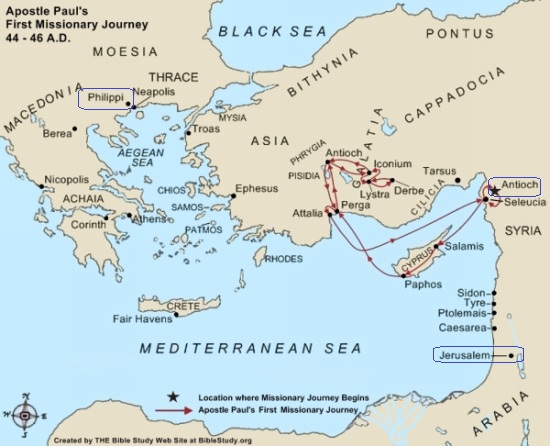Introduction
Before we begin reading any kind of document, it is important to ask some basic questions about that document:
- Who wrote the document? What do we know about that person?
- Where was the document produced?
- When was the it written? What was the situation at the time (political, social etc)?
- For whom did the author write the document? What do we know about the recipient(s)? What kind of document is it? History? Poetry? Sermon?
- Why was it written? What was the purpose of the document?
With these questions in mind, let’s look at the book of the Bible known as “Ephesians”. Reading a letter is like listening to one side of a telephone conversation, so we will have to do a little bit of detective work by looking at the text in order to discover the answers…
Who? (The Author)
The author identifies himself as Paul (1:1; 3:1) and the Early Church universally affirmed that St. Paul was the author of this letter.
However, in the Sixteenth Century, Erasmus began to question the letter’s authorship. Since then, many scholars question whether Paul was, in fact, the author, suggesting instead that the author was a disciple of Paul. The main reason for doubt is that the style of the letter is notably different from other letters of Paul.
While Ephesians is different from Paul’s other letters, the differences can be explained through context. Unlike in many of his letters, Paul is not responding to heresy or controversy, thus the tone and style of the letter is different from, say, Corinthians or Galatians. Likewise, the epistle contains many themes found in Paul’s other letters.
Where? (The Location)
As usual, the location of authorship document depends on the person we believe to be the author. The writer tells us that he is writing from prison (3:4; 4:1; 6:20). Those who affirm Pauline authorship associate this letter with Paul’s house arrest in Rome (Acts 28:16,30).
When? (The Date)
Assuming Pauline authorship in Rome, this epistle would be dated to the early 60’s, the same time as Philippians, Colossians and Philemon.
Those who assume that the document was written by one of Paul’s disciples date the epistle as late as the 90’s.
For Whom? (The Recipients)
This question is trickier than you might think. Although this document is known as “The epistle to the Ephesians”, mention of Ephesus (1:1) is not found in the earliest manuscripts. It is therefore possible that this was a circular letter written to a number of congregations, one of which was Ephesus.
History & Culture
Ephesus itself was a Roman metropolis in Asia, now modern southwest Turkey.

Church Founding
There was an Ephesian congregation prior to the missionary journeys of Paul(Acts 19:1), although it appears that their formation was not complete (Acts 19:2). Paul later spent a lot of time in this area preaching and teaching (Acts 19:1-10; 20:31).
Why? (Purpose)
Paul devotes most of the document to putting forth a vision of God’s redemptive work, brought about through Christ and manifested in the Church.
The Ephesians were mostly newly baptized Pagans and, because of this, some have referred to Ephesians as mystagogical catechesis.
Paul spends quite some time talking about “mystery”. This relates to Jesus’ sacrifice on the cross which draws man, both Jew and Gentile, back into relationship with God. This relationship is communicated through the Church, which has Christ as her head.
Assignment
To prepare for this Bible study, I recommend read the description of Paul’s interactions with the Ephesian Church and his ministry there (Acts 19:1-10; 20:31).
Welcome | Introduction | Chapter 1 | Chapter 2 | Chapter 3 | Chapter 4 | Chapter 5 | Chapter 6